Water floor heating convectors: types, features of installation and arrangement
Panoramic glazing of housing is a popular fashion trend of modern repair and construction. To heat a room with such windows, standard heating devices are not suitable, therefore, experts have developed built-in appliances of a hidden installation.
They are universal water floor heating convectors, favorably characterized by compactness and attractive appearance. Before deciding to use innovative equipment, you need to understand its features, agree?
The article describes in detail the various types of floor convectors, identifies the strengths and weaknesses of such radiators, and also gives tips on their selection and installation.
The content of the article:
- Floor convectors in the interior
- Where are built-in heating systems used?
- Types and features of equipment
- Basic requirements for the device body
- What type of grill to prefer?
- Features of underfloor water devices
- Differences between radiator and electric types
- Instrument selection rules
- Features of installation of floor convector
- Advantages and disadvantages of equipment
- Conclusions and useful video on the topic
Floor convectors in the interior
The modern market offers various heating equipment, which is designed to create a comfortable and cozy atmosphere in rooms for various purposes.
Floor models are universal devices that perform a heating and decorative function. They provide the desired temperature in the apartment or office for a short period of time.
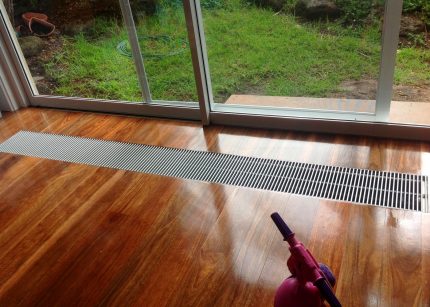
Connected to a water heating system or to a power supply, a convector is a multifunctional device that perfectly performs its direct functions and serves as an interior decoration.It not only plays the role of a compact, almost imperceptible heating equipment, but also is a stylish addition to the design of the room.
If the owner of the apartment has chosen to heat devices placed in the floor structure, during the repair process special niches should be prepared.
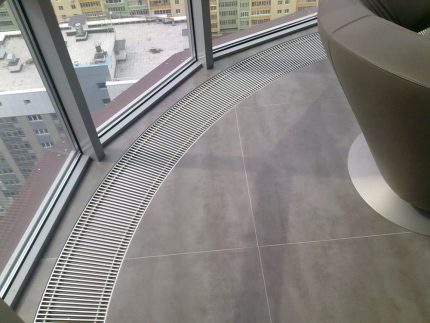
Built-in models are more attractive and efficient than conventional radiators. The latter heat the room with thermal radiation, and electric convectors and water models, in addition to radiation, also heat the air flow circulating through them.
Features of work, as well as recommendations for choosing electric and water convectors of the floor type are given in the articles:
- How to choose electric heating convectors: what to look at before buying + brand overview
- Water floor heating convectors: types, manufacturers, how to choose the best
Underfloor heating devices are closed on 3 sides, therefore, regardless of location, they give up most of the heat. Due to the use of special insulating materials, an insignificant part of the thermal energy is consumed.
Where are built-in heating systems used?
Convectors built into the floor - innovative heating equipment, which is characterized by unique characteristics and stylish appearance.
They are recommended to be installed in the following cases:
- In rooms with large window openingsto exclude the possibility of a draft in the room.
- In small rooms with a lack of free space or in those in which the design should not have extra elements. Devices are built into the floor screed, leaving maximum space free.
- In rooms with high humidity regardless of their purpose. Here, their role is to obtain a kind of curtain that does not allow fogging of windows.
In order not to be disappointed and avoid losing money, it is recommended to study the information about the models you like before buying.
A properly selected heating device will certainly live up to expectations and will significantly save on energy consumption.
Types and features of equipment
The design of the electrical integrated unit is quite simple. It consists of a metal case-box, in the middle of which a heating element is located. To maximize heat transfer, it is equipped with convective ribs. From above, the heater is closed by an aesthetic grill located at floor level.
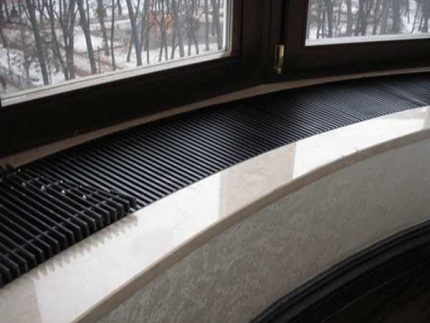
To increase the thermal power in some models put fans. They increase the speed of movement and heating of air by 75-90%. To reduce the noise arising from the operation of the fans, special inserts made of porous rubber are used.
If a large heat output is not required, the floor-standing appliance can function with the fan turned off due to natural convection.
To achieve optimal room temperature, regulators and temperature sensorswhich are located in the middle of the metal case. Regulators are electromechanical or electronic.
This unit controls the temperature and fan speed. Convenient "manual" control allows you to set the required parameters if necessary.
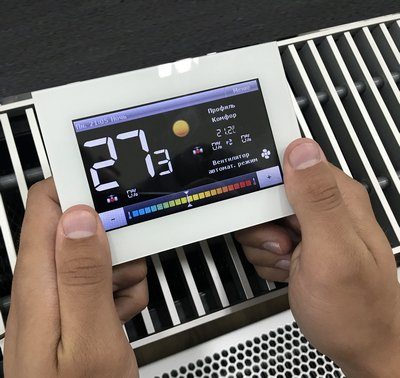
A heating appliance connected to the heating circuit differs from an electric heating device only in that instead of a heating element, a pipe passes inside it. By analogy, it is equipped with fins, the purpose of which is to increase heat transfer.
The water type of convectors built into the floor can also be equipped with fans to speed up the heating process.
Each element of the floor convector is made of various materials, has certain characteristics and performs its functions. Therefore, the quality and functionality of the heater should be evaluated on the basis of accessories.
A thermostat is built in to regulate the temperature, and a fan is used to increase the efficiency of the device.
Basic requirements for the device body
The appearance of the metal case does not play an important role, since it is located in the floor of the room. Particular attention should be paid to the quality of this element, since the reliability and durability of the heating unit depends on the indicator and its class is determined.
The important role is played by the metal of which the body is made:
- For installation in damp rooms, a convector with a housing made of stainless material with increased moisture resistance is suitable.
- In dry rooms, a device is selected with a housing made of galvanized or black steel, which is coated, resistant to external influences, with anti-corrosion paint
Typically, special powder formulations are used to coat a metal case. They effectively protect the metal from rust and external influences.
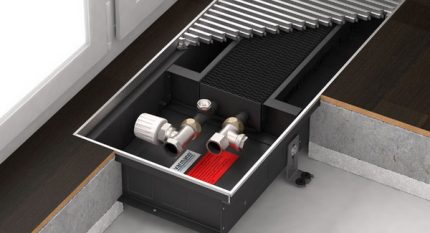
What type of grill to prefer?
When choosing a floor heating appliance, pay particular attention to the grill. This element has a decorative role, as it remains above the floor.
The grill can be made of such materials:
- galvanized, stainless or ordinary steel;
- anodized aluminum;
- natural marble;
- tree - beech, ash, merbau, oak, etc.
When choosing a material, one must take into account that the system should harmoniously fit into the interior and correspond to the design of the room.
By design, there are 2 types of gratings for floor convectors:
- rolled - gratings are more expensive and easy to use, as they can be rolled up;
- linear - must be fully raised.
Planks in roll gratings are located exclusively across. In a linear version, they are located across and along the heater.
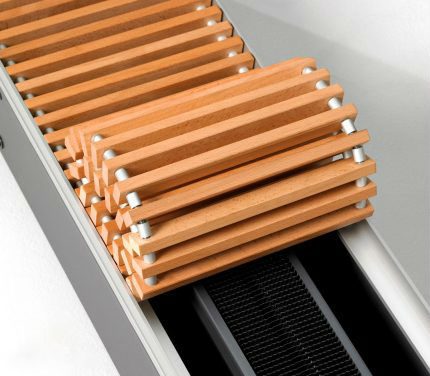
The design of the grill is especially important if it is stepped on top with legs. In this case, you need to pay attention to the appearance and materials used in the manufacture. It should be checked that the grill does not contain any plastic parts that manufacturers sometimes use at the junction of the frame and slats.
To evenly distribute the load on the device, reduce noise and increase comfort, individual manufacturers install springs at the junction of the frame and lamella.
Under conditions of increased load, it is better to choose a grill having the same design on both sides. If it is erased, it can be turned over for further use.
Features of underfloor water devices
The heating element of water heaters embedded in the floor is a hollow tube with pressed or welded plates. Heat transfer in progress coolant with antifreeze or water. Floor convectors are connected to a common water heating system using threaded pipes.
In embedded water products an important role is played by the heat exchanger. Maximum power is provided by more expensive copper and copper-aluminum heat exchangers. The latter are equipped with a copper pipe and aluminum fins.
Manufacturers also offer budget models made of stainless steel and the economy option - galvanized.
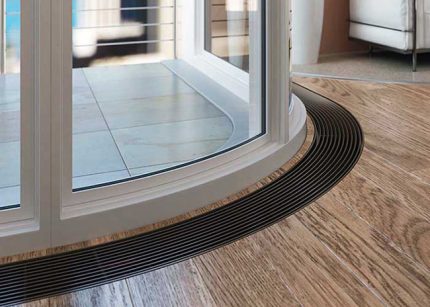
Expensive convectors equipped with copper heat exchangers, in addition to the function of increasing the power of the device, have several drawbacks.
Cons of using similar models:
- Copper requires special operating conditions. It is not compatible with some metals from which the coolant and grounding devices are made.
- Using models with heat exchangers made of this metal in a central heating system can cause problems.
But they are suitable for individual heating systems, where the wiring is polymer, metal-polymer or copper pipes. It is better if the heat exchanger of the boiler is also made of copper.
Fittings and fittings must be used with chrome and nickel plated, brass or bronze.
In addition to water, manufacturers offer electric built-in convectors. The main role in them is heating element - TEN. There are plates on it designed to increase the area of contact of the device with air.
These devices serve as an additional source of thermal radiation in rooms where it is not possible to connect water heating.
Differences between radiator and electric types
In electric and in water floor heating devices, fans are installed to increase power. This allows you to get much more heat from convectors.
The fans operate from a DC network of 12, 24 V and alternating current of 220 V. To reduce the noise level, they are placed on vibration-proof supports.
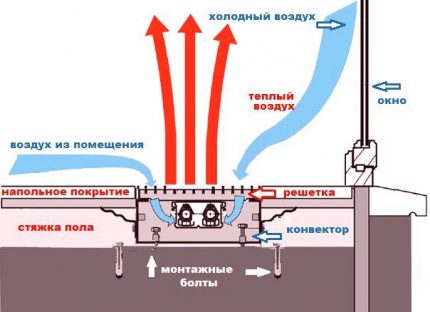
If the owner of the room plans to use the water floor convector as the sole or main source of heat, it is recommended to choose models with forced convection. They quickly and efficiently heat indoor air, preventing condensation from settling on the glass.
Individual models, e.g. company products Kermi, can be used not only for space heating, but also for its cooling. This is due to the use of 2 separate heat exchange elements connected to various systems - heating and cooling.
There are 2 types of embedded systems - two-pipe and four-pipe. In two-pipe 1 heat exchanger works with 2 systems.
On the modern market, modifications of floor convectors are presented that supply clean and warm air to the room. First, it enters a special hole, then it is cleaned with built-in filters. Then the air is heated, and then enters the room.
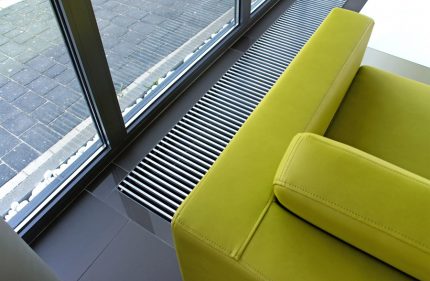
Manufacturers also produce floor-mounted appliances for efficient heating of residential, commercial and industrial premises with a high level of humidity. In their manufacture, moisture-resistant and modern electrical equipment is used.These models are equipped with a drain to drain accumulated condensate.
Before starting repairs, you can order a non-standard convector that matches the characteristics of the room.
Some manufacturers make rotary heating elements that make it easier to care for the inside of the case. The heat exchanger can be installed on flexible hoses, due to which it can be easily removed for cleaning.
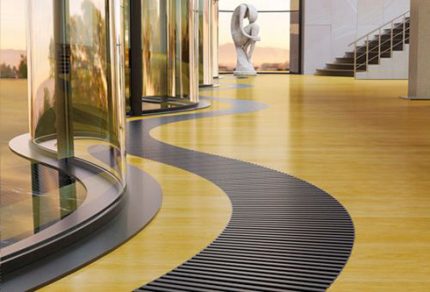
Electronic or electromechanical thermostats are responsible for controlling the temperature and power of the convector. They are located in the device body, controlled by remote or remote control. Electronic thermostats allow you to program the temperature according to the time of day, days of the week.
Instrument selection rules
When choosing an electric type floor convector, the main thing is to evaluate the power and dimensions of the device. It is also desirable to determine the type of convection, which can be natural and forced.
The choice of water heaters built into the floor requires taking into account many parameters of the functional features of the device.
The main characteristics of the convector
Initially, you need to choose the size of the product, the presence of a fan, the material of the body, ribs, pipes. In addition, special attention must be paid to other characteristics.
Considering the built-in convector of water type as a device for heating homes, you should decide on the manufacturer.
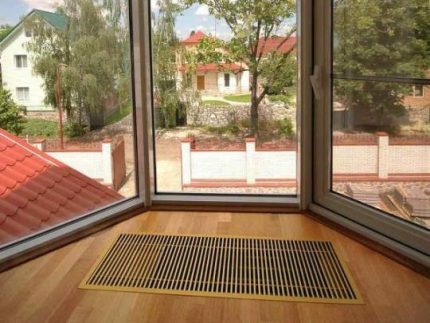
One of the most important characteristics of a convector is considered to be the type of heating system - one-pipe or two-pipe. Connection diameters do not apply to paramount selection criteria, as there are adapters.
Heating system pressure
This is one of the most important indicators of a water device. Any model is suitable for heating a private house, a two-story and a three-story cottage, since the pressure in the general heating system is usually not higher than 3 Bar.
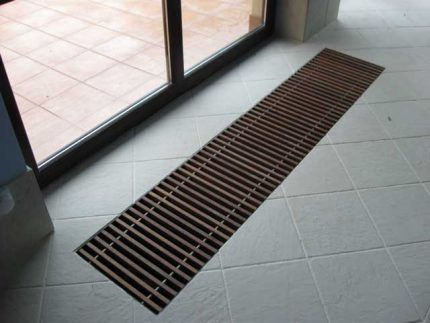
For apartments of high-rise buildings, it is necessary to take into account the pressure and working pressure. In the operating organization, you should find out these indicators for your home by comparing them with the characteristics of the selected model.
The choice of coolant
When choosing the optimal model of the floor convector, it is necessary to take into account the type and parameters of the device. Any model is suitable for individual heating, as the owner of the room can independently set and control the temperature and characteristics of the coolant.
Residents of high-rise buildings will have to adapt to the conditions and indicators of water that flows in sewer pipes. The following factors should be taken into account: temperature, amount of suspensions, Ph, oxygen content, optimal type of device connection.
Features of installation of floor convector
You can install built-in models of convectors for heating water-type in several ways: with the appliance to the room or to the glass.
If the equipment is deployed to the window, the cold air coming from the window opening will be cut off, which will make condensation impossible. However, the temperature in the room will extremely slowly reach values that are comfortable for staying, since most of the heat will be spent on heating the glass.
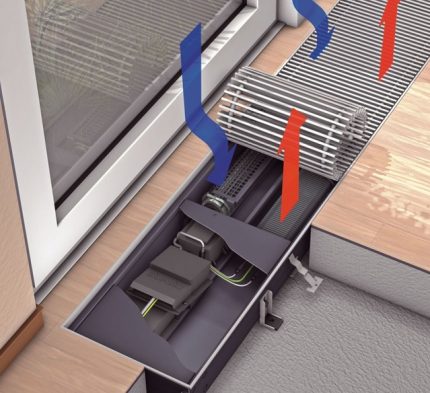
By turning the device towards the room, you can get fast heating. With this arrangement, condensation may form on the glass. One of the main disadvantages of this method is that zones with different temperatures are observed in the room, which create discomfort.
Built-in appliances are installed in gutters prepared in the course of repair work. If the floor in the room is concrete, then the distance between the walls of the gutter and the body of the device is filled with a solution.
When installing the convector in a wooden floor covering, a decorative frame is made of bars of the same color around it.
Advantages and disadvantages of equipment
On the modern market there are a huge number of floor and wall mounted heating devices. Universal floor-mounted devices are especially popular, as they have unique characteristics and advantages.
Cons of embedded appliances
The main disadvantage of floor structures is the high cost. Their price is several times higher than similar heating devices of an outdoor unit of the same power.
This is due to the fact that the installation of the device is much more complicated than conventional convectors.
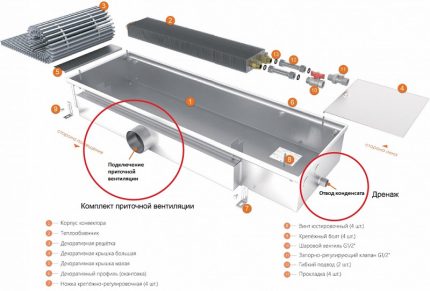
When installing equipment of a built-in type, the supply pipes must be in the floor. This is a popular solution, complicated from a technical point of view. For hidden installation of the product, it is necessary to raise the floor, which can not be done in all rooms.
Pros of floor systems
The main advantage of floor convectors is flush mounting, which provides ample opportunity for bold design decisions. This is a suitable option for equipping display cases and panoramic glazing.

For open, stylish interiors, the installation of heating appliances can be a problem due to lack of free space. In most apartments and houses equipped with fashionable panoramic windows, a bulky radiator does not fit into the overall style of the room.
The optimal solution in such situations is a built-in convector. Moreover, you can choose a model with natural or forced convection.
Conclusions and useful video on the topic
Video number 1. Overview of built-in equipment for water heating:
Video number 2. The device and installation of floor convectors:
Video number 3. Care for floor heating products:
The main function of the water convector integrated in the floor is efficient and quick heating of the room. The equipment protects the glass from the formation of condensation - with the help of a thermal curtain it stops and heats the flows of cold air that constantly come from window and door openings.
Depending on the characteristics of the room and the requirements for the product, you can choose the device of the optimal model.
Those who are interested in the issue of choosing and installing water floor convectors we suggest leaving comments and asking questions. The discussion form is located in the lower block.

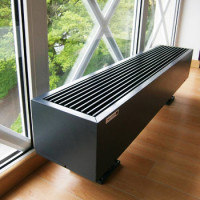 Water floor heating convectors: types, manufacturers, how to choose the best
Water floor heating convectors: types, manufacturers, how to choose the best 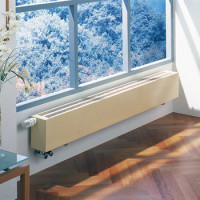 Water heating convectors: types, how to choose + an overview of popular models and brands
Water heating convectors: types, how to choose + an overview of popular models and brands 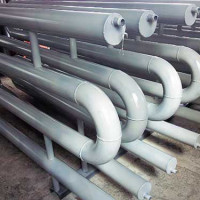 Heating registers: types of structures, calculation of parameters, installation features
Heating registers: types of structures, calculation of parameters, installation features 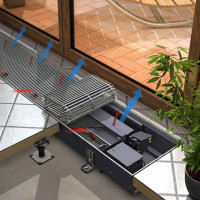 How to choose electric heating convectors: what to look at before buying + brand overview
How to choose electric heating convectors: what to look at before buying + brand overview  Infrared heating panels: types, principle of operation, features of installation and operation
Infrared heating panels: types, principle of operation, features of installation and operation 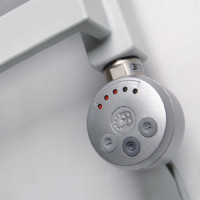 Heating elements for heating radiators: purpose, types, selection criteria, connection features
Heating elements for heating radiators: purpose, types, selection criteria, connection features  How much does it cost to connect gas to a private house: the price of organizing gas supply
How much does it cost to connect gas to a private house: the price of organizing gas supply  The best washing machines with dryer: model rating and customer tips
The best washing machines with dryer: model rating and customer tips  What is the color temperature of light and the nuances of choosing the temperature of the lamps to suit your needs
What is the color temperature of light and the nuances of choosing the temperature of the lamps to suit your needs  Replacement of a geyser in an apartment: replacement paperwork + basic norms and requirements
Replacement of a geyser in an apartment: replacement paperwork + basic norms and requirements
It is precisely that the main function of water convectors is to heat a room quickly and efficiently. And this means that there is still no such result as from the good old radiators. And the issue of convector pollution is unclear. Dust will accumulate there, and given that it is located on the floor, there will be a considerable amount of dirt. How to deal with this, or let everything scatter from it back to the room?
Hello. Floor convectors can be with removable heat exchangers and not. In the second version, the dust does not practically get inside, and outside it is quite convenient to clean. In the first case, a thorough cleaning helps after disconnecting with an ordinary vacuum cleaner and a damp cloth.
We are all used to the fact that apartments and houses usually have batteries. When we started to build a house, we also wanted to install water batteries out of habit. It is good that one smart person advised reading about floor convectors. Cool stuff! It costs, of course, more expensive, but then you will rejoice. Firstly, these appliances do not spoil the interior. Secondly, during operation they are cheaper.
We installed water, as electricity is still more expensive. In our room, the windows are large, panoramic. I don’t even know where we would put ordinary batteries, if we did heating the old fashioned way. The grill that closes the convector, I advise you to buy a linear one. It comes out a little more expensive, but it looks prettier. It is easy to assemble. It’s easier to take care of her, but with a linear one you are tormented.
As for the dust, of course it will accumulate in the box. Therefore, we advise everyone to put shut-off valves in front of the heat exchanger inside the duct. Using them, it is possible not only to cut off and dismantle the heat exchanger by washing or vacuuming the duct, but also to regulate the heat transfer of the convector.